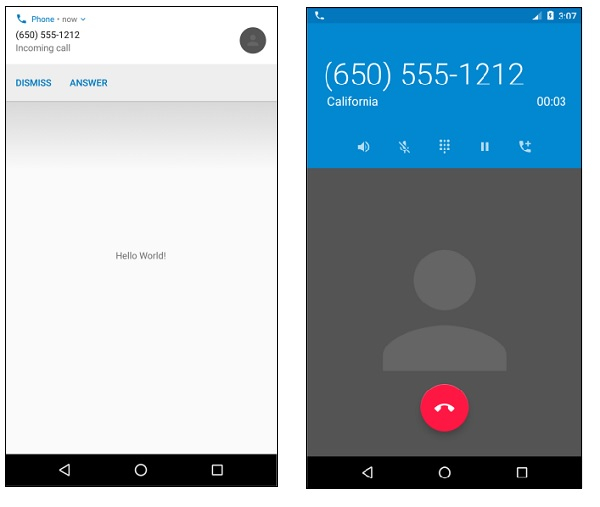
 Data Structure
Data Structure Networking
Networking RDBMS
RDBMS Operating System
Operating System Java
Java MS Excel
MS Excel iOS
iOS HTML
HTML CSS
CSS Android
Android Python
Python C Programming
C Programming C++
C++ C#
C# MongoDB
MongoDB MySQL
MySQL Javascript
Javascript PHP
PHP
- Selected Reading
- UPSC IAS Exams Notes
- Developer's Best Practices
- Questions and Answers
- Effective Resume Writing
- HR Interview Questions
- Computer Glossary
- Who is Who
How to answer in incoming call programmatically in Android?
This example demonstrates how to answer in incoming call programmatically in Android.
Step 1 − Create a new project in Android Studio, go to File ⇒ New Project and fill all required details to create a new project.
Step 2 − Add the following code to res/layout/activity_main.xml.
<?xml version="1.0" encoding="utf-8"?> <androidx.constraintlayout.widget.ConstraintLayout xmlns:android="http://schemas.android.com/apk/res/android" xmlns:tools="http://schemas.android.com/tools" xmlns:app="http://schemas.android.com/apk/res-auto" android:layout_width="match_parent" android:layout_height="match_parent" tools:context=".MainActivity"> <TextView android:layout_width="wrap_content" android:layout_height="wrap_content" android:text="Hello World!" app:layout_constraintBottom_toBottomOf="parent" app:layout_constraintLeft_toLeftOf="parent" app:layout_constraintRight_toRightOf="parent" app:layout_constraintTop_toTopOf="parent" /> </androidx.constraintlayout.widget.ConstraintLayout>
Step 3 − Add the following code to src/MainActivity.java
package com.app.sample; import androidx.appcompat.app.AppCompatActivity; import android.content.Context; import android.content.Intent; import android.os.Build; import android.os.Bundle; public class MainActivity extends AppCompatActivity { @Override protected void onCreate(Bundle savedInstanceState) { super.onCreate(savedInstanceState); setContentView(R.layout.activity_main); } public void acceptCall() { Context context = null; if (Build.VERSION.SDK_INT >= 21) { Intent answerCalintent = new Intent(context, AcceptCallActivity.class); answerCalintent.addFlags(Intent.FLAG_ACTIVITY_NEW_TASK | Intent.FLAG_ACTIVITY_CLEAR_TASK | Intent.FLAG_ACTIVITY_EXCLUDE_FROM_RECENTS); answerCalintent.setFlags(Intent.FLAG_ACTIVITY_NEW_TASK); context.startActivity(answerCalintent); } else { Intent intent = new Intent(context, AcceptCallActivity.class); intent.addFlags(Intent.FLAG_ACTIVITY_NEW_TASK | Intent.FLAG_ACTIVITY_CLEAR_TASK | Intent.FLAG_ACTIVITY_EXCLUDE_FROM_RECENTS); intent.setFlags(Intent.FLAG_ACTIVITY_NEW_TASK); context.startActivity(intent); } } } Step 4 − Add the following code to src/AcceptCallActivity.java
package com.app.sample; import android.app.Activity; import android.app.KeyguardManager; import android.content.BroadcastReceiver; import android.content.Context; import android.content.Intent; import android.content.IntentFilter; import android.media.AudioManager; import android.os.Build; import android.os.Bundle; import android.telephony.TelephonyManager; import android.view.KeyEvent; import android.view.WindowManager; import java.io.IOException; import java.util.logging.Logger; public class AcceptCallActivity extends Activity { private static Logger logger = Logger.getLogger(String.valueOf(AcceptCallActivity.class)); private static final String MANUFACTURER_HTC = "HTC"; private KeyguardManager keyguardManager; private AudioManager audioManager; private CallStateReceiver callStateReceiver; @Override protected void onCreate(Bundle savedInstanceState) { super.onCreate(savedInstanceState); keyguardManager = (KeyguardManager) getSystemService(Context.KEYGUARD_SERVICE); audioManager = (AudioManager) getSystemService(Context.AUDIO_SERVICE); } @Override protected void onResume() { super.onResume(); registerCallStateReceiver(); updateWindowFlags(); acceptCall(); } @Override protected void onPause() { super.onPause(); if (callStateReceiver != null) { unregisterReceiver(callStateReceiver); callStateReceiver = null; } } private void registerCallStateReceiver() { callStateReceiver = new CallStateReceiver(); IntentFilter intentFilter = new IntentFilter(); intentFilter.addAction(TelephonyManager.ACTION_PHONE_STATE_CHANGED); registerReceiver(callStateReceiver, intentFilter); } private void updateWindowFlags() { if (keyguardManager.inKeyguardRestrictedInputMode()) { getWindow().addFlags( WindowManager.LayoutParams.FLAG_DISMISS_KEYGUARD | WindowManager.LayoutParams.FLAG_TURN_SCREEN_ON | WindowManager.LayoutParams.FLAG_SHOW_WHEN_LOCKED); } else { getWindow().clearFlags( WindowManager.LayoutParams.FLAG_DISMISS_KEYGUARD | WindowManager.LayoutParams.FLAG_KEEP_SCREEN_ON | WindowManager.LayoutParams.FLAG_SHOW_WHEN_LOCKED); } } private void acceptCall() { boolean broadcastConnected = MANUFACTURER_HTC.equalsIgnoreCase(Build.MANUFACTURER) && !audioManager.isWiredHeadsetOn(); if (broadcastConnected) { broadcastHeadsetConnected(false); } try { try { Runtime.getRuntime().exec("input keyevent " + Integer.toString(KeyEvent.KEYCODE_HEADSETHOOK)); } catch (IOException e) { String enforcedPerm = "android.permission.CALL_PRIVILEGED"; Intent btnDown = new Intent(Intent.ACTION_MEDIA_BUTTON).putExtra( Intent.EXTRA_KEY_EVENT, new KeyEvent(KeyEvent.ACTION_DOWN, KeyEvent.KEYCODE_HEADSETHOOK)); Intent btnUp = new Intent(Intent.ACTION_MEDIA_BUTTON).putExtra( Intent.EXTRA_KEY_EVENT, new KeyEvent(KeyEvent.ACTION_UP, KeyEvent.KEYCODE_HEADSETHOOK)); sendOrderedBroadcast(btnDown, enforcedPerm); sendOrderedBroadcast(btnUp, enforcedPerm); } } finally { if (broadcastConnected) { broadcastHeadsetConnected(false); } } } private void broadcastHeadsetConnected(boolean connected) { Intent i = new Intent(Intent.ACTION_HEADSET_PLUG); i.addFlags(Intent.FLAG_RECEIVER_REGISTERED_ONLY); i.putExtra("state", connected ? 1 : 0); i.putExtra("name", "mysms"); try { sendOrderedBroadcast(i, null); } catch (Exception e) { } } private class CallStateReceiver extends BroadcastReceiver { @Override public void onReceive(Context context, Intent intent) { finish(); } } } Step 5 − Add the following code to Manifests/AndroidManifest.xml
<?xml version="1.0" encoding="utf-8"?> <manifest xmlns:android="http://schemas.android.com/apk/res/android" package="com.app.sample" > <application android:allowBackup="true" android:icon="@mipmap/ic_launcher" android:label="@string/app_name" android:roundIcon="@mipmap/ic_launcher_round" android:supportsRtl="true" android:theme="@style/AppTheme" > <activity android:name=".MainActivity" > <intent-filter> <action android:name="android.intent.action.MAIN" /> <category android:name="android.intent.category.LAUNCHER" /> </intent-filter> </activity> </application> </manifest>
Let's try to run your application. I assume you have connected your actual Android Mobile device with your computer. To run the app from the android studio, open one of your project's activity files and click Run ![]() icon from the toolbar. Select your mobile device as an option and then check your mobile device which will display your default screen −
icon from the toolbar. Select your mobile device as an option and then check your mobile device which will display your default screen −

Click here to download the project code.

